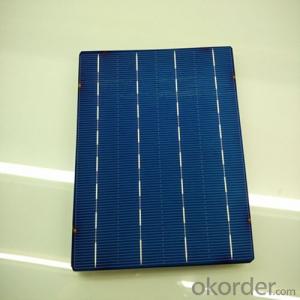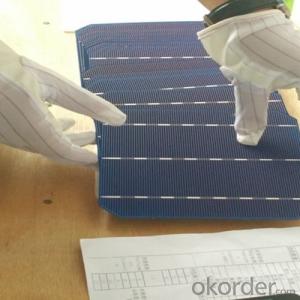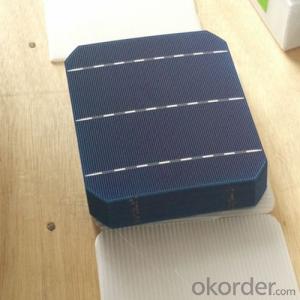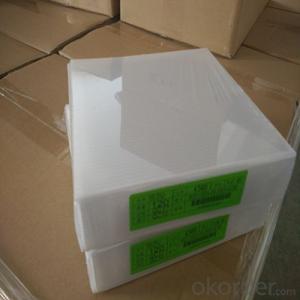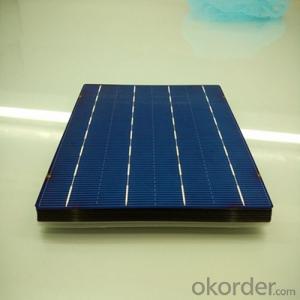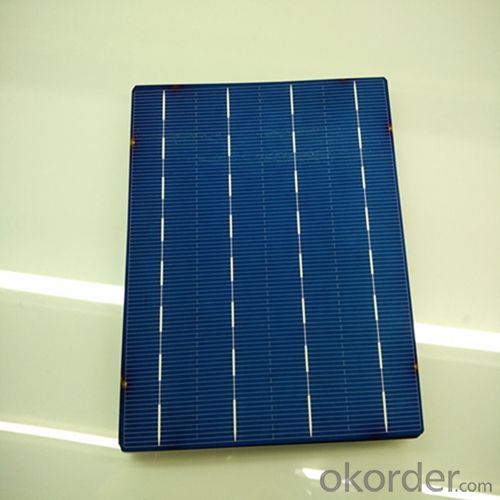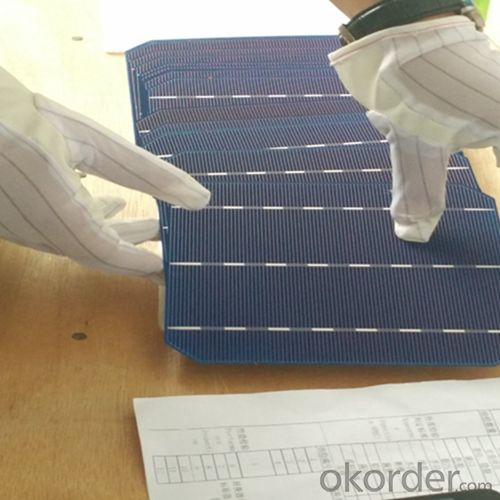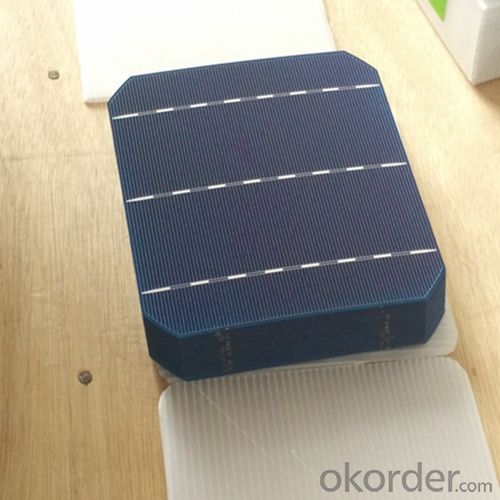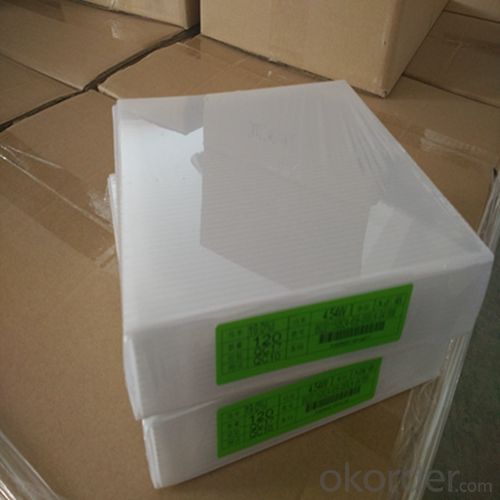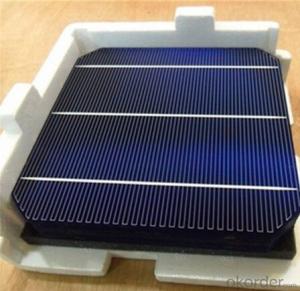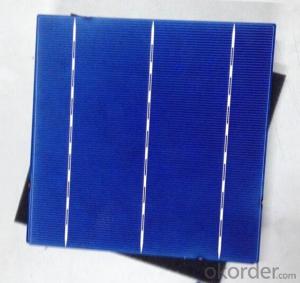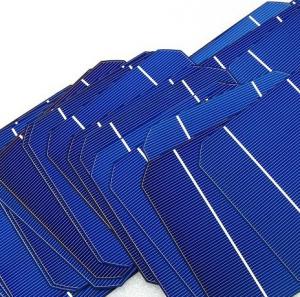Thin Film Silicon Solar Cells - Poly 156x156mm2 Solar Cells Made in Mono 1
- Loading Port:
- Shanghai
- Payment Terms:
- TT OR LC
- Min Order Qty:
- 2999 watt
- Supply Capability:
- 6000000 watt/month
OKorder Service Pledge
OKorder Financial Service
You Might Also Like
The operation of a photovoltaic (PV) cell requires 3 basic attributes:
The absorption of light, generating either electron-hole pairs or excitons.
The separation of charge carriers of opposite types.
The separate extraction of those carriers to an external circuit.
In contrast, a solar thermal collector supplies heat by absorbing sunlight, for the purpose of either direct heating or indirect electrical power generation from heat. A "photoelectrolytic cell" (photoelectrochemical cell), on the other hand, refers either to a type of photovoltaic cell (like that developed by Edmond Becquerel and modern dye-sensitized solar cells), or to a device that splits water directly into hydrogen and oxygen using only solar illumination.Characteristic of Mono 156X156MM2 Solar Cells
You are gaining energy independence - add battery backup power for even greater energy security
The cost of electricity is only going to rise – insure against that rising cost
Adaptive cells change their absorption/reflection characteristics depending to respond to environmental conditions. An adaptive material responds to the intensity and angle of incident light. At the part of the cell where the light is most intense, the cell surface changes from reflective to adaptive, allowing the light to penetrate the cell. The other parts of the cell remain reflective increasing the retention of the absorbed light within the cell.[67]
In 2014 a system that combined an adaptive surface with a glass substrate that redirect the absorbed to a light absorber on the edges of the sheet. The system also included an array of fixed lenses/mirrors to concentrate light onto the adaptive surface. As the day continues, the concentrated light moves along the surface of the cell. That surface switches from reflective to adaptive when the light is most concentrated and back to reflective after the light moves along
Mechanical data and design
Format | 156mm x 156mm±0.5mm |
Thickness | 210μm±40μm |
Front(-) | 1.5mm bus bar (silver),blue anti-reflection coating (silicon nitride) |
Back (+) | 2.5mm wide soldering pads (sliver) back surface field (aluminium) |
Temperature Coefficient of Cells
Voc. Temp.coef.%/K | -0.35% |
Isc. Temp.coef .%/K | +0.024%/K |
Pm.Temp.coef. %/K | -0.47%/K |
Electrical Characteristic
Effiency(%) | Pmpp(W) | Umpp(V) | Impp(A) | Uoc(V) | Isc(A) | FF(%) |
18.35 | 4.384 | 0.526 | 8.333 | 0.63 | 8.877 | 78.39% |
18.20 | 4.349 | 0.526 | 8.263 | 0.63 | 8.789 | 78.54% |
18.05 | 4.313 | 0.525 | 8.216 | 0.63 | 8.741 | 78.32% |
17.90 | 4.277 | 0.524 | 8.161 | 0.625 | 8.713 | 78.04% |
17.75 | 4.241 | 0.523 | 8.116 | 0.625 | 8.678 | 77.70% |
17.60 | 4.206 | 0.521 | 8.073 | 0.625 | 8.657 | 77.36% |
17.45 | 4.170 | 0.519 | 8.039 | 0.625 | 8.633 | 76.92% |
17.30 | 4.134 | 0.517 | 8.004 | 0.625 | 8.622 | 76.59% |
17.15 | 4.096 | 0.516 | 7.938 | 0.625 | 8.537 | 76.80% |
17.00 | 4.062 | 0.512 | 7.933 | 0.625 | 8.531 | 76.18% |
16.75 | 4.002 | 0.511 | 7.828 | 0.625 | 8.499 | 75.34% |
16.50 | 3.940 | 0.510 | 7.731 | 0.625 | 8.484 | 74.36% |
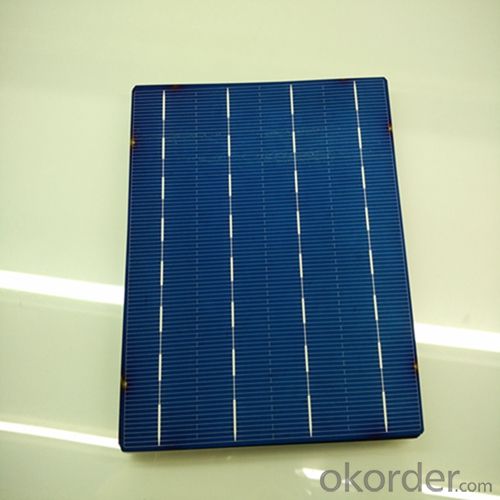
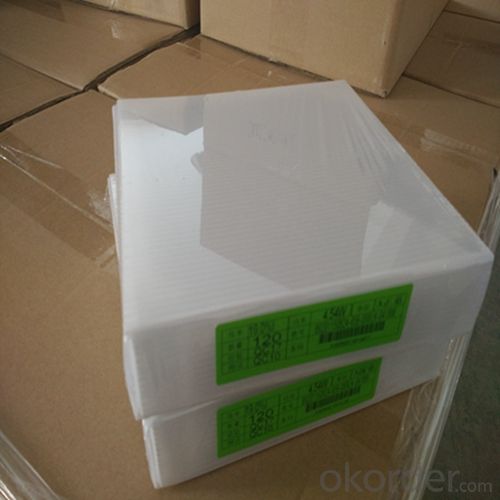
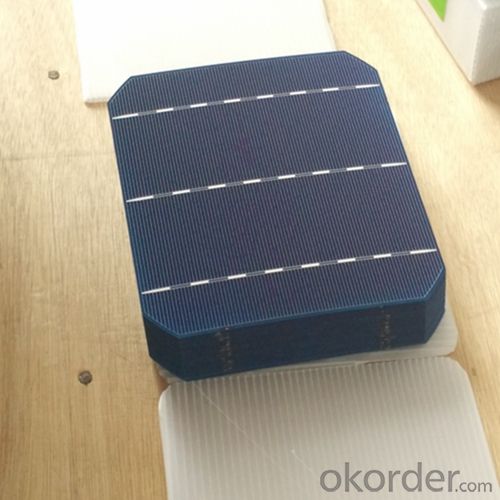
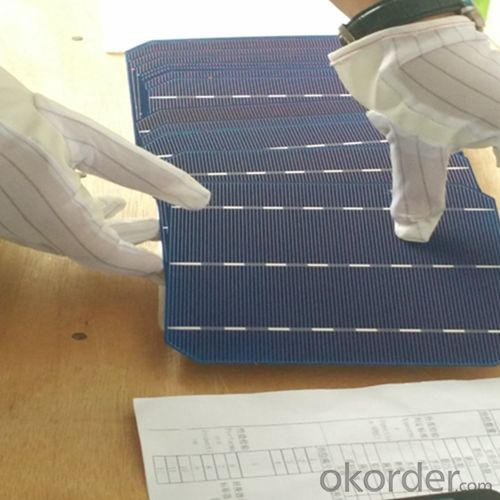
 FAQ
FAQ
Q: What price for each watt?
A: It depends on the quantity, delivery date and payment terms, generally Large Quantity and Low Price
Q: What is your size for each module? Can you tell me the Parameter of your module?
A: We have different series of panels in different output, both c-Si and a-Si. Please take the specification sheet for your reference.
Q: What is your size for each module? Can you tell me the Parameter of your module?
A: We have different series of panels in different output, both c-Si and a-Si. Please take the specification sheet for your reference.
- Q: What are the tin bands, sinks and interconnections used on solar modules, and what are the solar cells used in the solar cells?
- The bus bar and the interconnection are of the same effect, are collected with the charge, the interconnection of a single cell is to collect the charge
- Q: Can solar cells be used in remote areas with no access to electricity?
- Yes, solar cells can be used in remote areas with no access to electricity. Solar cells convert sunlight into electricity, making them an ideal solution for areas with no grid connection. They can provide a reliable source of power for various applications, including lighting, charging electronic devices, and running small appliances, thereby improving the lives of people in remote areas.
- Q: I know that solar cells are produced by DC and then converted into alternating current through the inverter, who explains why the solar cell is produced by DC?
- The electrons flow from the p region to the n region, and the current is formed after the circuit is turned on. This is the photoelectric effect of the working principle of solar cells. In the PN junction in the direction of electronic movement is fixed, is irreversible, so the resulting DC
- Q: What's the benefit of using a solar cell?
- It can decrease the damage to our environment.
- Q: How are solar cells used in calculators?
- Solar cells are used in calculators to convert sunlight into electrical energy, which powers the device and allows it to function without the need for batteries or external power sources.
- Q: How do solar cells impact job creation?
- Solar cells impact job creation by creating a demand for skilled workers in the solar industry. As the adoption of solar energy grows, more jobs are created in manufacturing, installation, maintenance, and research and development of solar cells. This not only helps stimulate the economy but also provides employment opportunities for individuals in a rapidly expanding sector.
- Q: Is A grade better than the B grade when we buy the poly solar cells.
- We did a test based on 10 poly solar cells we bought in the market, and it turns our 5 of the poly solar cells claimed to be A grade product is just the same as the B grade.
- Q: How do solar cells perform in areas with frequent hurricanes?
- Solar cells can still perform efficiently in areas with frequent hurricanes, provided they are properly installed and designed to withstand severe weather conditions. It is crucial to use durable materials and secure mounting systems to ensure the panels are not damaged or dislodged during high winds. Additionally, incorporating measures like reinforced frames and hurricane-resistant glass can further enhance their resilience. However, it is important to note that extreme weather events may temporarily disrupt solar power generation due to damaged infrastructure or reduced sunlight availability.
- Q: Is solar cell technology very developed and v applied to life a lot?
- Ever since scientists discovered the solar cell, it has been very much a part of our life.
- Q: How do solar cells compare to other renewable energy sources?
- Solar cells have several advantages over other renewable energy sources. They are highly versatile and can be installed in various locations, from rooftops to large-scale solar farms. Solar energy is abundant and accessible in most parts of the world, making it a reliable and widely available source of power. Additionally, solar cells have a low environmental impact, as they produce electricity without emitting greenhouse gases or other pollutants. Finally, solar energy is becoming increasingly cost-effective, with declining prices for solar panels and improved efficiency. However, solar cells do have limitations, such as dependence on sunlight availability and the need for large areas of land for large-scale installations. Nonetheless, their numerous advantages make solar cells a valuable and promising renewable energy option.
Send your message to us
Thin Film Silicon Solar Cells - Poly 156x156mm2 Solar Cells Made in Mono 1
- Loading Port:
- Shanghai
- Payment Terms:
- TT OR LC
- Min Order Qty:
- 2999 watt
- Supply Capability:
- 6000000 watt/month
OKorder Service Pledge
OKorder Financial Service
Similar products
Hot products
Hot Searches
Related keywords
